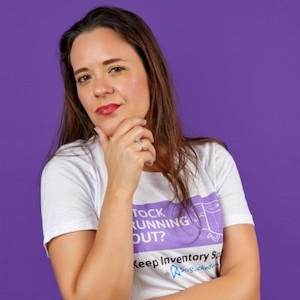March 7, 2025
by Chelsea Cohen, co-founder of SoStocked by Carbon6
Growing an Amazon business isn’t just about increasing revenue—it’s about maximizing profit and optimizing cash flow. To scale effectively, sellers must shift from focusing on sales volume alone to designing a business that is built for expansion. That means making data-driven decisions based on true unit economics, capital utilization, and cash velocity.
Take a skincare seller who hits $50,000 in monthly sales but has trapped every dollar in inventory. After analyzing her unit economics, she discovers her best-selling face cream is actually her least profitable product. By shifting focus from pure sales to a more strategic approach, she learns that reducing the size of her packaging will reduce costs, building a leaner, more profitable business that facilitates growth.
In this guide, we’ll show you how to analyze your true profit drivers, optimize your inventory management, and implement Amazon cash flow strategies that set you up for sustainable growth in 2025.
Understanding True Unit Economics
Many sellers make decisions based on estimated costs rather than actual, ever-changing expenses. True unit economics measures the real cost to produce and fulfill a product, revealing actual profit margins and guiding smarter capital allocation. Over time, deviations from initial estimates can lead sellers to keep investing in low-margin products instead of focusing on more profitable ones.
Why It Matters
Suppose an Amazon seller initially priced their product based on a 30% expected margin. However, after a six-month review, they realized that increased shipping and ads costs and rising Amazon fees had eroded their margin down to just 12%. Had they not conducted a unit economics audit, they would have continued investing in a product with diminishing profitability rather than reinvesting their time and cash into more lucrative products.
Key Costs to Audit Biannually
• Shipping – Are you overpaying for inefficient shipping methods?
• Ad Spend – Are customer acquisition costs cutting into margins?
• Amazon Fulfillment and Storage Fees – Could resizing your products put you into lower fee tiers?
Regular unit economics audits ensure your capital is working in the right places, maximizing profitability.
Capital Utilization: Making Your Money Work Harder
Every dollar in your business should be deployed efficiently. If you could make $800 or $1,600 with the same amount of capital, the choice is clear—but many sellers fail to analyze these trade-offs.
Capital Utilization in Action
Product A has a 10% profit margin, generating $800 monthly profit.
Product B has a 20% profit margin, generating $1,600 monthly profit with the same investment.
The Opportunity Cost
In ecommerce, opportunity cost is the potential revenue or growth lost when choosing one investment, strategy, or product over another, impacting profitability and scalability. If you keep your capital in Product A for three months instead of switching to Product B:
• Product A earns: $800 × 3 months = $2,400 total profit
• Product B would have earned: $1,600 × 3 months = $4,800 total profit
• The opportunity cost (or “loss”): $4,800 – $2,400 = $2,400
If capital is utilized for Product A and funds are not reallocated to the better opportunity, the total opportunity cost over three months is $2,400. A good Amazon success strategy is to know the best return on investment before committing capital. Poor allocation can cost more than you realize.
Velocity of Money: The Cash Conversion Cycle
The speed at which you sell through inventory directly impacts your ability to scale. The faster your money moves, the faster it multiplies.
How Speed Impacts Growth
Imagine two sellers:
• Seller A turns inventory every 120 days
• Seller B turns inventory every 60 days
If both start with $10,000 in capital and a 30% margin per cycle:
• Seller A earns $3,000 profit per cycle × 3 cycles per year = $9,000 annual profit
• Seller B earns $3,000 profit per cycle × 6 cycles per year = $18,000 annual profit
Seller B is able to double Seller A’s annual profits by turning inventory twice as fast. This demonstrates the velocity of money—the faster you convert inventory into cash and reinvest it, the faster your business grows.
Action Steps For Profit & Cash Flow Optimization
To optimize profit and cash flow, take strategic action in the following key areas.
1) Audit Your True Unit Economics
Reviewing actual costs (versus estimates) every six months ensures you stay informed about your real margins. Adjusting pricing, advertising and supply chain strategies based on shifting expenses can significantly impact the bottom line. For example, sellers who audit their logistics costs may discover an alternative option that is 10% cheaper, adding thousands of dollars back to their bottom line.
2) Reallocate Capital Strategically
Identifying high-margin, high-turnover products helps sellers make better investment decisions. A real-world example is a seller who realizes their best-selling product yields a 40% margin, while another product only generates 10%. By shifting ad spend toward the more profitable product and allocating restocking budget to new product launches, they significantly increase their net profit and growth potential.
3) Optimize Inventory Turns
Using Amazoninventory forecasting toolsto avoid excess inventory and negotiating with suppliers for faster restock cycles can improve cash flow. For instance, a seller who extends their payment terms from 30 days to 60 days can reinvest their cash twice as fast, compounding their growth potential.
4) Reduce Amazon Fees and Unnecessary Costs
Monitoring Amazon FBA fee changes and adjusting accordingly helps sellers stay ahead of expenses. Additionally, increasing your units per carton can lower box processing costs. A great example is a seller who increases units per carton from 10 to 30, effectively reducing Amazon Warehousing Distribution (AWD) processing fees by 66% and saving nearly $1,800 on a 10,000-unit shipment.
Master Amazon Cash Flow & Scale Smarter
Winning on Amazon isn’t just about selling more—it’s about making every dollar work harder. Sellers who optimize profit margins, reallocate capital wisely, and accelerate cash velocity can turn cash flow from a stress point into a growth engine.
Want to learn more about protecting your profits and scaling your Amazon business? Join Chelsea Cohen at Prosper Show 2025 for an exclusive breakout session, “Margin Pressure: 9-Figure Strategies to Reverse Profit Erosion,” on Thursday, March 27, from 9:00 AM to 9:50 AM in Las Vegas. You’ll discover detailed frameworks and strategies for improving profitability while scaling your business, along with exclusive case stories from sellers who have successfully navigated margin pressures—so you can stop profit erosion before it starts. Secure your spot at the Prosper Show today.
 Chelsea Cohen is the co-founder of SoStocked by Carbon6, an Amazon inventory forecasting software that prevents stockouts and costly storage fees by predicting demand, automating reorder points, and preventing fees. She started as an Amazon seller in 2014.
Chelsea Cohen is the co-founder of SoStocked by Carbon6, an Amazon inventory forecasting software that prevents stockouts and costly storage fees by predicting demand, automating reorder points, and preventing fees. She started as an Amazon seller in 2014.

